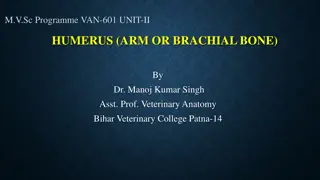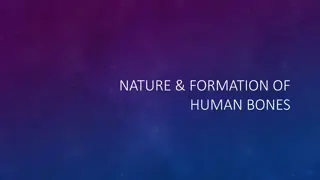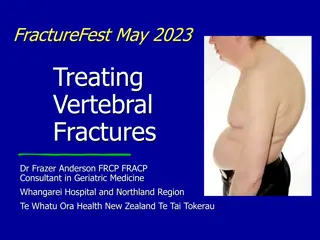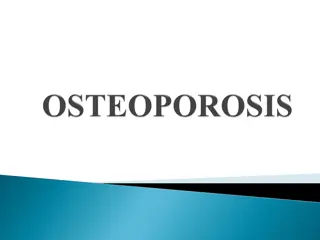Understanding Bone and Cartilage: An Overview
Bones are essential rigid connective tissues in the human body made up of cells and extracellular matrix. The lecture delves into the cellular components of bone tissue, highlighting osteoprogenitor cells, osteoblasts, osteocytes, and osteoclasts, each with specific functions in bone maintenance and remodeling. Various types of bones, such as long bones, short bones, flat bones, and sesamoid bones, are discussed, emphasizing their structural and functional roles in the body.
Download Presentation

Please find below an Image/Link to download the presentation.
The content on the website is provided AS IS for your information and personal use only. It may not be sold, licensed, or shared on other websites without obtaining consent from the author. Download presentation by click this link. If you encounter any issues during the download, it is possible that the publisher has removed the file from their server.
E N D
Presentation Transcript
Department of Anesthesia Techniques Department of Anesthesia Techniques Title of the lecture: Title of the lecture:- -Bone & Cartilage Prof. Dr. Younis A. Alkhafaji Younis.Abdulridha@uomus.edu.iq Younis.Abdulridha@uomus.edu.iq Lecture Lecture 6 6 -- -- Bone & Cartilage Bones : rigid specialized connective tissue consisting of cells embedded in an abundant hard intercellular material. The 206 bones in the adult human body. Bone is made up of Cells and Extracellular matrix: Extracellular matrix Inorganic Hydroxyapatite and other calcium salts(Contributes to hardness and resistance to compression forces). Organic Collagen type I and most common protein. Ground substance proteoglycans. Contributes to tensile strength.
Department of Anesthesia Techniques Department of Anesthesia Techniques Title of the lecture: Title of the lecture:- - Bone & Cartilage Prof. Dr. Younis A. Alkhafaji Younis.Abdulridha@uomus.edu.iq Younis.Abdulridha@uomus.edu.iq Bone & Cartilage Bone cells Bones are not a static tissue but need to be constantly maintained and remodeled. There are three main cell types involved in this process. 1 - Osteoprogenitor cells, also known as osteogenic cells, are undifferentiated cells. Can divided to replace themselves and become osteoblast. 2 - Osteoblasts: These are responsible for making new bone and repairing older bone. Osteoblasts produce a protein mixture called osteoid, which is mineralized and becomes bone. 3 - Osteocytes: These are inactive osteoblasts that have become trapped in the bone that they have created. They maintain connections to other osteocytes and osteoblasts. They are important for communication within bone tissue. 4 - Osteoclasts: These are large cells with more than one nucleus. Its function is to break down bone. They release enzymes and acids to dissolve minerals in bone and digest them. This process is called resorption. Osteoclasts help remodel injured bones and create pathways for nerves and blood vessels to travel through.
Department of Anesthesia Techniques Department of Anesthesia Techniques Title of the lecture: Title of the lecture:- - Bone & Cartilage Prof. Dr. Younis A. Alkhafaji Younis.Abdulridha@uomus.edu.iq Younis.Abdulridha@uomus.edu.iq Bone & Cartilage
Department of Anesthesia Techniques Department of Anesthesia Techniques Title of the lecture: Title of the lecture:- - Bone & Cartilage Prof. Dr. Younis A. Alkhafaji Younis.Abdulridha@uomus.edu.iq Younis.Abdulridha@uomus.edu.iq Bone & Cartilage Types of bone There are five types of bones in the human body: 1. Long bones: These are mostly compacted bone with little marrow and include most of the bones in the limbs. These bones tend to support weight and help movement. 2. Short bones: Only a thin layer of compact bone, these include bones of the wrist and ankle. 3. Flat bones: Usually bones that are thin and curved. They consist of two outer layers of compact bone and an inner layer of spongy bone. Flat bones include most of the bones of the skull and the sternum or breastbone. They tend to have a protective role. 4. Sesamoid bones: These are embedded in tendons, such as the patella or kneecap. They protect tendons from wear and stress.
Department of Anesthesia Techniques Department of Anesthesia Techniques Title of the lecture: Title of the lecture:- - Bone & Cartilage Prof. Dr. Younis A. Alkhafaji Younis.Abdulridha@uomus.edu.iq Younis.Abdulridha@uomus.edu.iq Bone & Cartilage 5 - Irregular bones: As their name implies, these are bones that do not fit into the first four categories and are an unusual shape. They include the bones of the spine and pelvis. They are often protecting organs or tissues.
Department of Anesthesia Techniques Department of Anesthesia Techniques Title of the lecture: Title of the lecture:- - Bone & Cartilage Prof. Dr. Younis A. Alkhafaji Younis.Abdulridha@uomus.edu.iq Younis.Abdulridha@uomus.edu.iq Bone & Cartilage There are two types of mature bone: 1. Compact - which is found in the long bones. This makes up 80% of all bone. 2. Spongy (cancellous) bone - which is found at the ends of long bones. This makes up 20% of all bone Bone tissue The different layers of bone tissue include: Periosteum the dense, tough outer shell that contains blood vessels and nerves. Compact or dense tissue the hard, smooth layer that protects the tissue within. Spongy or cancellous tissue the porous, honeycombed material found inside most bones, which allows the bone to be strong yet lightweight. Bone marrow the jelly-like substance found inside the cavities of some bones (including the pelvis) that produces blood cells.
Department of Anesthesia Techniques Department of Anesthesia Techniques Title of the lecture: Title of the lecture:- - Bone & Cartilage Prof. Dr. Younis A. Alkhafaji Younis.Abdulridha@uomus.edu.iq Younis.Abdulridha@uomus.edu.iq Bone & Cartilage
Department of Anesthesia Techniques Department of Anesthesia Techniques Title of the lecture: Title of the lecture:- - Bone & Cartilage Prof. Dr. Younis A. Alkhafaji Younis.Abdulridha@uomus.edu.iq Younis.Abdulridha@uomus.edu.iq Bone & Cartilage Bones functions Support - bones make up a structural framework for the body, and provide attachment sites for muscles. Protection - protection of internal organs - i.e. brain, heart and lungs, Assisting movement. Mineral homeostasis - the bone is a store for calcium and phosphorus Blood cell production - takes place in the bone marrow. Cartilages Cartilage is a specialized type of connective tissue. Consists, like other connective tissues, of cells and extracellular components. Cartilage is a flexible connective tissue, including the joints between bones, the rib cage, the ear, the nose, the bronchial tubes and the intervertebral discs. It is not as hard and rigid as bone, but it is stiffer and less flexible than muscle.
Department of Anesthesia Techniques Department of Anesthesia Techniques Title of the lecture: Title of the lecture:- - Bone & Cartilage Prof. Dr. Younis A. Alkhafaji Younis.Abdulridha@uomus.edu.iq Younis.Abdulridha@uomus.edu.iq Bone & Cartilage Cartilage ECM It consists of a dense network of collagen fibers and elastic fibers embedded in chondroitin sulfate, a gel like component of the ground substance. Cartilage is nourished (feed) by diffusion of gases and nutrients through this gel. Cartilage cells 1. Chondrogenic cells: Are spindle -shaped, narrow cells that derived from mesenchymal cells. These cells can differentiate into chondroblasts. 2. Chondroblasts: immature cartilage-producing cells. They are derived from two sources; Mesenchymal cells and Chondrogenic cells. 3. Chondrocytes: mature cartilage cells, they occur singly or in groups within space called lacunae in the extracellular matrix.
Department of Anesthesia Techniques Department of Anesthesia Techniques Title of the lecture: Title of the lecture:- - Bone & Cartilage Prof. Dr. Younis A. Alkhafaji Younis.Abdulridha@uomus.edu.iq Younis.Abdulridha@uomus.edu.iq Bone & Cartilage A covering of dense irregular connective tissue called the perichondrium surrounds the surface of most cartilage and contains blood vessels and nerves and is the source of new cartilage cells. Cartilage is avascular and possesses no lymph vessels or nerves. Types Of Cartilage 1 - Hyaline cartilage: Provides smooth surfaces for movement at joints, flexibility, and support. It found at ends of long bones, anterior ends of ribs, nose, parts of larynx, trachea, embryonic and fetal skeleton. 2 - Elastic cartilage: Provides strength and elasticity; maintains shape of certain structures. It is found in Lid on top of larynx (epiglottis), part of external ear (auricle). 3 - Fibrocartilage : Provides strength under stress and Support and joining structures together. It is found in intervertebral discs and knee.























